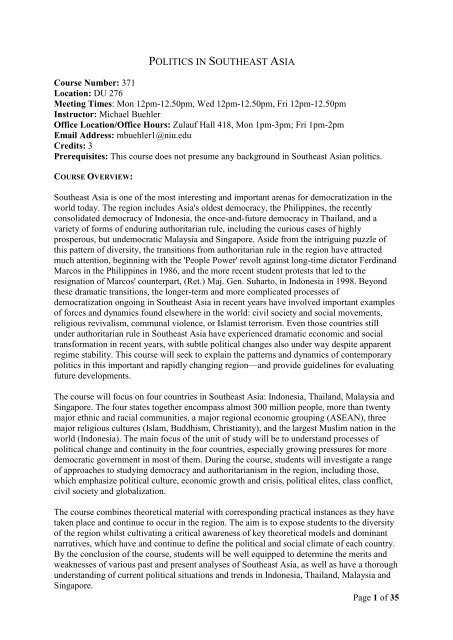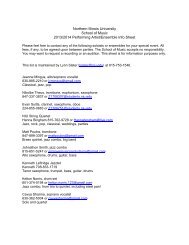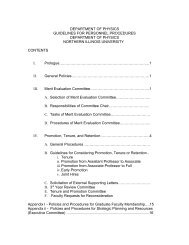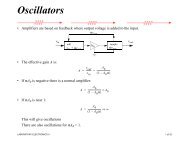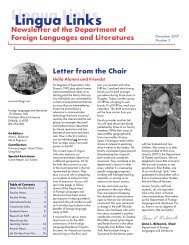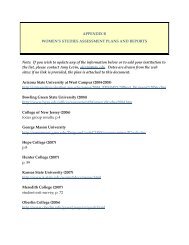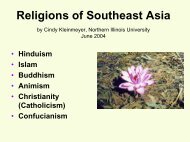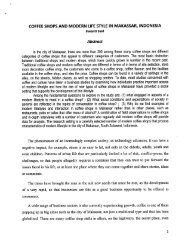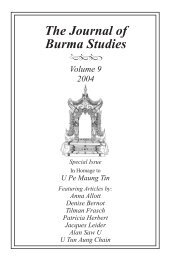AUTHORITARIANISM AND DEMOCRACY IN SOUTHEAST ASIA
AUTHORITARIANISM AND DEMOCRACY IN SOUTHEAST ASIA
AUTHORITARIANISM AND DEMOCRACY IN SOUTHEAST ASIA
You also want an ePaper? Increase the reach of your titles
YUMPU automatically turns print PDFs into web optimized ePapers that Google loves.
POLITICS <strong>IN</strong> <strong>SOUTHEAST</strong> <strong>ASIA</strong><br />
Course Number: 371<br />
Location: DU 276<br />
Meeting Times: Mon 12pm-12.50pm, Wed 12pm-12.50pm, Fri 12pm-12.50pm<br />
Instructor: Michael Buehler<br />
Office Location/Office Hours: Zulauf Hall 418, Mon 1pm-3pm; Fri 1pm-2pm<br />
Email Address: mbuehler1@niu.edu<br />
Credits: 3<br />
Prerequisites: This course does not presume any background in Southeast Asian politics.<br />
COURSE OVERVIEW:<br />
Southeast Asia is one of the most interesting and important arenas for democratization in the<br />
world today. The region includes Asia's oldest democracy, the Philippines, the recently<br />
consolidated democracy of Indonesia, the once-and-future democracy in Thailand, and a<br />
variety of forms of enduring authoritarian rule, including the curious cases of highly<br />
prosperous, but undemocratic Malaysia and Singapore. Aside from the intriguing puzzle of<br />
this pattern of diversity, the transitions from authoritarian rule in the region have attracted<br />
much attention, beginning with the 'People Power' revolt against long-time dictator Ferdinand<br />
Marcos in the Philippines in 1986, and the more recent student protests that led to the<br />
resignation of Marcos' counterpart, (Ret.) Maj. Gen. Suharto, in Indonesia in 1998. Beyond<br />
these dramatic transitions, the longer-term and more complicated processes of<br />
democratization ongoing in Southeast Asia in recent years have involved important examples<br />
of forces and dynamics found elsewhere in the world: civil society and social movements,<br />
religious revivalism, communal violence, or Islamist terrorism. Even those countries still<br />
under authoritarian rule in Southeast Asia have experienced dramatic economic and social<br />
transformation in recent years, with subtle political changes also under way despite apparent<br />
regime stability. This course will seek to explain the patterns and dynamics of contemporary<br />
politics in this important and rapidly changing region—and provide guidelines for evaluating<br />
future developments.<br />
The course will focus on four countries in Southeast Asia: Indonesia, Thailand, Malaysia and<br />
Singapore. The four states together encompass almost 300 million people, more than twenty<br />
major ethnic and racial communities, a major regional economic grouping (ASEAN), three<br />
major religious cultures (Islam, Buddhism, Christianity), and the largest Muslim nation in the<br />
world (Indonesia). The main focus of the unit of study will be to understand processes of<br />
political change and continuity in the four countries, especially growing pressures for more<br />
democratic government in most of them. During the course, students will investigate a range<br />
of approaches to studying democracy and authoritarianism in the region, including those,<br />
which emphasize political culture, economic growth and crisis, political elites, class conflict,<br />
civil society and globalization.<br />
The course combines theoretical material with corresponding practical instances as they have<br />
taken place and continue to occur in the region. The aim is to expose students to the diversity<br />
of the region whilst cultivating a critical awareness of key theoretical models and dominant<br />
narratives, which have and continue to define the political and social climate of each country.<br />
By the conclusion of the course, students will be well equipped to determine the merits and<br />
weaknesses of various past and present analyses of Southeast Asia, as well as have a thorough<br />
understanding of current political situations and trends in Indonesia, Thailand, Malaysia and<br />
Singapore.<br />
Page 1 of 35
GRAD<strong>IN</strong>G:<br />
I) Class Attendance& Class Participation (10% of total grade):<br />
Students are expected to have read at least the required readings each week to allow<br />
informed and thoughtful discussion. Students are strongly encouraged to read beyond the set<br />
passages as it not merely enlivens discussion, but is borne out in written work and exams. At<br />
least one other reading should be consulted in the course of the week.<br />
Each student will be required to give one brief oral critical presentation of 10 minutes<br />
length. Students are required to prepare a single-sided sheet highlighting the main<br />
points they wish to make in their presentation. They should make enough copies to distribute<br />
to all class members and email a copy to the instructor at mbuehler1@niu.edu<br />
For the presentation, the following points should be taken as a guideline for the student‘s<br />
critical analysis:<br />
What are the main questions and propositions being examined in the written text(s)?<br />
How are those questions and propositions ―answered‖ or explained?<br />
In other words, students presenting need to understand what is being said in the text and how<br />
this is being explained or answered (particular theories used, historical or comparative<br />
approaches, particular models of the state alluded to or implied etc.) To do this without<br />
reading other similar texts is difficult, as you have no reference point. Your task is not to say<br />
whether ‗you thought the author was on the right track or not‘. Critical insights should be<br />
substantiated from a) contrary or confirming opinion found in the literature on the topic, and<br />
b) confirming or contrary evidence from contemporary media sources.<br />
Students will be awarded marks for participating actively in seminars (not just attending).<br />
Attendance will be recorded. More than two absences will lower a student’s final grade by<br />
a full mark (e.g. ―A‖ will be reduced to ―B―)<br />
II) Essay (40% of total grade): One 2500 word essay due in Week 14 on topics to be<br />
determined in close consultation with the instructor. Students are asked to turn in a research<br />
question and tentative bibliography of the essay in class during Week 6. A research<br />
outline is due in Week 11.<br />
The grade of the research paper is broken down as follows:<br />
Research Question and Statement: 5% (Week 6)<br />
Research Outline: 5% (Week 11)<br />
Final Paper: 30% (Week 14)<br />
Papers will be graded on the substance of the paper, the research thoroughness and the<br />
presentation of the material. Essay writing is an essential part of the learning process and a<br />
vital medium through which a student‘s understanding of a subject can develop and be<br />
assessed. Good academic writing usually contains the following attributes:<br />
Arguments supported by reference to secondary and, if possible, primary material<br />
Adequate range of sources<br />
Central question or issue clearly defined and answered<br />
Page 2 of 35
Discussion of key issues and relevant narrative<br />
Logical flow of ideas and arguments<br />
Evidence of creative thought and articulation of own ideas<br />
Contains adequate introduction and conclusion<br />
Conclusions supported by evidence and argument<br />
Fluent and succinct writing<br />
Accurate spelling, grammar and punctuation<br />
Neat presentation<br />
Full bibliography of references cited in the essay<br />
When preparing essays, students should use the above list as a guide. It is particularly<br />
important to engage critically with source materials. Do not accept without question the<br />
views or interpretations given in the works which you read. Use them instead as a means of<br />
finding your own way into the problem at hand. Your essays should be more than simply a<br />
report of other people‘s views but instead should demonstrate your own understanding of the<br />
question or issue.<br />
It is also especially important to remember that an essay should contain more than<br />
description of some issue or problem, but should advance a particular argument, supported<br />
by evidence and leading to a conclusion, as a way of resolving or responding to a question or<br />
problem.<br />
Late submission will result in grade reduction for a full-mark per day (e.g. ―A‖ will be<br />
reduced to ―B― if submission is a day late.<br />
Grading Standards:<br />
A: The argument is clearly articulated and logically developed, using relevant evidence. The<br />
research is of high quality, cleverly ordered to support the argument with an original and<br />
creative synthesis of materials and displaying understanding of wider issues. The presentation<br />
is of high standard.<br />
B: The argument is well proposed but the structure is not fully developed. The research is<br />
quite extensive but sources are not fully utilized which limits the ability to be creative and<br />
deal with a full range of issues. The presentation is solid but can be improved.<br />
C: The argument is satisfactory, with some limitations, but the structure is not well thought<br />
out. The research used is just adequate, but insufficient to develop fully the argument or<br />
display much originality. The presentation is adequate but could be improved.<br />
D: While the essay displays a basic understanding of the subject, the argument lacks<br />
coherence and logical development. The research is basic and the use of evidence does not<br />
sufficiently support the argument nor display originally or understanding of wider issues. The<br />
presentation is not of sufficient standard.<br />
F: The presentation is well below acceptable standard. The essay is incoherent with glaring<br />
misunderstandings.<br />
Page 3 of 35
Grade Scale:<br />
A+ 4.33 (given extremely rarely - for extraordinary performance)<br />
A 4.00<br />
A- 3.67<br />
B+ 3.33<br />
B 3.0<br />
B- 2.67<br />
C+ 2.33<br />
C 2.0<br />
C- 1.67<br />
D+ 1.33<br />
D 1.00<br />
D- 0.67<br />
F 0.00<br />
Style Guide:<br />
1. Within the thematic framework provided by the instructor, choose an original topic, and<br />
make it as specific as possible. For example, instead of writing about ―Health Security in the<br />
Asia-Pacific Region‖, focus on ―HIV/AIDS Prevention Programs in Thailand and Burma: A<br />
Comparison‖.<br />
2. Before you start writing, think about a compelling and provocative argument that you want<br />
to present in your essay. Do not limit yourself to a narrative description of your topic.<br />
3. After you have decided on a topic and argument, and after you have collected all the<br />
necessary materials, think about how you want to structure your essay. It is essential that you<br />
have a clear idea of this structure before you begin the writing process.<br />
4. Every essay needs a title. Do not simply use the research question as your headline. A title<br />
should give the reader an idea about the content and, if possible, the argument of your paper.<br />
An attractive title is of extreme importance, since most readers refer to the title alone when<br />
deciding whether to read an article or not.<br />
5. Start your essay with an introduction. This introduction should lay out the topic, the<br />
analytical question you are trying to answer, and your main argument(s). There is no need to<br />
summarize the whole article in the introduction – just anticipate some of its main points.<br />
6. The main body of the text gives you the opportunity to develop your argument, and to back<br />
it up with empirical evidence. It is important that this section is structured logically, and that<br />
its various parts form coherent units. Use sub-headers to help the reader to identify the<br />
themes of individual subsections.<br />
7. If you are not a strong writer, refrain from using long sentences that you cannot control.<br />
Use shorter sentences. Make use of commas to structure your sentences and put emphasis on<br />
their content.<br />
Page 4 of 35
8. Remember that written language is substantially different from spoken language. If you<br />
are unsure about the kind of academic language that is appropriate for a scholarly essay, look<br />
at articles in acknowledged social science journals as examples.<br />
9. Complete your essay with a short, precise conclusion. This conclusion should pull all<br />
narrative and analytical strings together, and formulate a clear, compelling argument.<br />
10. All papers submitted for the class are expected to follow appropriate formats for citation<br />
and bibliography. Use the Harvard System of Referencing. Details can be found online at<br />
http://libweb.anglia.ac.uk/referencing/harvard.htm The bibliography needs to be coherent,<br />
and in line with the chosen system of citation.<br />
11. In terms of sources, it is acceptable – and, in fact, expected – to make use of non-scholarly<br />
sources to update your material. Newspaper or magazine articles can be quoted if they refer<br />
to newer sources than those cited in scholarly articles. If, for example, a scholarly article<br />
mentions the number of HIV infections in Thailand in 2003, it is expected that you browse the<br />
internet to find credible sources for the newest data.<br />
Academic Integrity Statement:<br />
It is our hope that your experience at Northern Illinois University will prepare you in a<br />
positive way for success in all you do. With that in mind, we are providing the following<br />
information to assist you in understanding proper methods of citation and the effects of<br />
plagiarism.<br />
To better understand how to use citations and how to avoid plagiarism, visit these links:<br />
http://www.ulib.niu.edu/information/citingresources.cfm<br />
http://www.lib.monash.edu.au/tutorials/citing/<br />
http://library.nsuok.edu/tutorials/BSOL/bsol_citationplagiarism.html<br />
http://lrs.tvu.ac.uk/find/Plagiarism_tutorial/index.html<br />
http://library.camden.rutgers.edu/EducationalModule/Plagiarism/<br />
At NIU, plagiarism is considered cheating and constitutes a violation of The Student Code of<br />
Conduct defined as Academic Misconduct:<br />
3-3.1 Academic Misconduct. Receipt or transmission of unauthorized aid on assignments or<br />
examinations, plagiarism, unauthorized use of examination materials, or other forms of<br />
dishonesty in academic matters.<br />
If you still need assistance after reviewing the information at the links above, contact your<br />
instructor<br />
III) Written Exams (50% of total grade):<br />
The grade of the exams is broken down as follows:<br />
Page 5 of 35
One 1 hour in-house examination in week 8 that includes short-answer questions based on<br />
the first 7 weeks of the course: 30%<br />
One 2 hour in-house examination in week 16 that includes short- and long answer questions<br />
based on the 15 weeks of the course: 70%<br />
<strong>IN</strong>-CLASS LAPTOP <strong>AND</strong> CELL PHONE USE:<br />
In-class laptop and cell phone use is not allowed.<br />
Go to http://www.youtube.com/watch?v=GPbMpadn9ZA to see what happens if you get<br />
caught using your phone in class.<br />
STUDENTS WITH DISABILITIES:<br />
NIU abides by Section 504 of the Rehabilitation Act of 1973 that mandates reasonable<br />
accommodations for students with disabilities. If you have a disability, contact me early in<br />
the semester so that I can help to address your needs. You will need to register with the<br />
Center for Access-Ability Resources (CAAR) on campus on the 4 th floor of the University<br />
Health Services building (753-1303.)<br />
Page 6 of 35
COURSE SCHEDULE<br />
22-28 Aug Week 1 DEMOCRATIZATION: A THEORETICAL OVERVIEW<br />
19 Aug-4 Sep Week 2 ‗<strong>ASIA</strong>N VALUES‘ <strong>AND</strong> <strong>DEMOCRACY</strong><br />
05-11 Sep Week 3 THE COMPARATIVE HISTORICAL SOCIOLOGY OF <strong>SOUTHEAST</strong> <strong>ASIA</strong><br />
12-18 Sep Week 4 THE TREND TO <strong>AUTHORITARIANISM</strong>: THE MILITARY <strong>AND</strong> POLITICS <strong>IN</strong><br />
<strong>IN</strong>DONESIA <strong>AND</strong> THAIL<strong>AND</strong><br />
19-25 Sep Week 5 THE POLITICAL DYNAMICS OF RAPID DEVELOPMENT: STABLE ‗SEMI-<br />
<strong>DEMOCRACY</strong>‘ <strong>IN</strong> MALAYSIA <strong>AND</strong> S<strong>IN</strong>GAPORE?<br />
26 Sep-2 Oct Week 6 ECONOMIC CRISIS <strong>AND</strong> DEMOCRATIZATION: MIDDLE CLASSES-<br />
VANGUARD OF REFORM OR AUTHORITARIAN DEAD WEIGHT?<br />
[RESEARCH QUESTION <strong>AND</strong> TENTATIVE BIBLIOGRAPHY]<br />
3 Oct- 9 Oct Week 7 DEMOCRATIZATION <strong>AND</strong> CIVIL SOCIETY: NON-PARLIAMENTARY<br />
OPPOSITION<br />
10-16 Oct Week 8 MID-TERM<br />
17-23 Oct Week 9 DEMOCRATIZATION <strong>AND</strong> ETHNICITY<br />
24-30 Oct Week 10 DEMOCRATIZATION <strong>AND</strong> RELIGION: ISLAM <strong>AND</strong> POLITICS<br />
31 Oct-6 Nov Week 11 DEMOCRATIZATION <strong>AND</strong> GENDER [RESEARCH OUTL<strong>IN</strong>E]<br />
7-13 Nov Week 12 RECENT POLITICAL DEVELOPMENTS I: <strong>DEMOCRACY</strong> UPRIS<strong>IN</strong>GS <strong>IN</strong><br />
MALAYSIA <strong>AND</strong> <strong>IN</strong>DONESIA COMPARED<br />
14-20 Nov Week 13 RECENT POLITICAL DEVELOPMENTS II: <strong>DEMOCRACY</strong>, CRISIS,<br />
REFORM <strong>AND</strong> REACTION <strong>IN</strong> THAIL<strong>AND</strong><br />
21-27 Nov Week 14 TOWARD DEMOCRATIC CONSOLIDATION? VIEWS FROM THE LOCAL<br />
LEVEL [ESSAY]<br />
29 Nov-5 Dec Week 15 CAN <strong>DEMOCRACY</strong> WORK?<br />
6 Dec Week 16 F<strong>IN</strong>AL EXAM<br />
RESOURCES<br />
The following sources may be useful to you in this course.<br />
Collections with country-specific chapters<br />
Acharya, Amitav (1998). Democratising Southeast Asia: economic crisis and political<br />
change. Murdoch, WA: Asia Research Centre, Murdoch University.<br />
Alagappa, Muthiah , editor (1995). Political legitimacy in Southeast Asia: the quest for moral<br />
authority. Stanford: Stanford University Press.<br />
Alagappa, Muthiah, editor (2001). Coercion and governance: the declining political role of<br />
the military in Asia. Stanford: Stanford University Press.<br />
Antlov, Hans and Tak-Wing Ngo (1998). The cultural construction of politics in Asia.<br />
Copenhagen and London: Nordic Institute of Asian Studies (NIAS) and Curzon Press.<br />
Brown, David (1994). The state and ethnic politics in Southeast Asia. London: Routledge.<br />
(chap. 1, 3, 4, 5, 6, 7).<br />
Case, William (2002). Politics in Southeast Asia: Democracy or Less, Richmond, Surrey:<br />
Curzon.<br />
Funston, John, editor (2001). Government and politics in Southeast Asia, Singapore : Institute<br />
of Southeast Asian Studies.<br />
Hefner, Robert, editor (1998). Market cultures: society and morality in the new Asian<br />
capitalisms. St Leonards: Allen and Unwin.<br />
Page 7 of 35
Hefner, Robert and Horvatich, Patricia, editors (1997). Islam in an era of nation-states:<br />
politics and religious renewal in Muslim Southeast Asia. Honolulu: University of Hawaii<br />
Press.<br />
Heryanto, Ariel and Mandal, Sumit K., editors (2003) Challenging authoritarianism in<br />
Southeast Asia : comparing Indonesia and Malaysia. London; New York : RoutledgeCurzon,<br />
Hinnells, John, editor (1985). A handbook of living religions. Penguin.<br />
Kahn, Joel, editor (1998). Southeast Asian identities: culture and the politics of representation<br />
in Indonesia, Malaysia, Singapore and Thailand. Singapore: Institute of Southeast Asian<br />
Studies.<br />
Maidment, Richard et al. editors (1998). Governance in the Asia-Pacific. London: Routledge<br />
Rigg, Jonathon (1997). Southeast Asia: the human landscape of modernization and<br />
development. London, Routledge.<br />
Robison, Richard and Goodman, David, editors (1996). The new rich in Asia. London:<br />
Routledge.<br />
Rodan, Garry, editor (1996). Political oppositions in industrialising Asia. London: Routledge.<br />
Rodan, Garry et al. editors (1997). The political economy of Southeast Asia: an introduction.<br />
Oxford: Oxford University Press.<br />
Suryadinata, Leo, editor (2000). Nationalism and globalization: East and West. Singapore:<br />
Institute of Southeast Asian Studies.<br />
Taylor, R. H., editor (1996). The politics of elections in Southeast Asia. Cambridge:<br />
Cambridge University Press.<br />
Vatikiotis, Michael (1996). Political change in Southeast Asia. London: Routledge.<br />
Yao Souchou, editor (2000) House of glass: culture, modernity, and the state in Southeast<br />
Asia. Singapore: ISEAS<br />
Websites<br />
AsiaSource (The Asia Society) www.asiasource.org<br />
Asian Studies WWW virtual library coombs.anu.edu.au/WWWVL-AsianStudies.html<br />
International Crisis Group www.crisisweb.org<br />
SEAsia on-line news services www.niu.edu/acad/cseas/seanews.html<br />
Inside Indonesia (quarterly) www.insideindonesia.org<br />
Aliran (critical Malaysian monthly) www.malaysia.net/aliran<br />
Focus on the global south (links and library) www.focusweb.org<br />
Thai Development Research Institute www.tdri.or.th<br />
Regional newspapers<br />
The Straits Times (Singapore daily) www.straitstimes.asia1.com.sg<br />
The Jakarta Post (daily) www.thejakartapost.com<br />
Economist Country Briefings www.economist.com/countries<br />
Asiaweek (weekly magazine) www.pathfinder.com/asiaweek<br />
Far Eastern Economic Review (weekly magazine) www.feer.com<br />
Tempo (Indonesian political weekly) www.tempointeractive.com<br />
Detikcom (daily, bahasa Indonesia) www.detik.com<br />
Gatra (Indonesian political weekly, English) www.gatranews.com<br />
Gamma (weekly, bahasa Indonesia) www.gamma.co.id<br />
The Bangkok Post (Thailand daily) www.bangkokpost.com<br />
The Nation (Thailand daily) www.nationmultimedia.com<br />
The New Straits Times (Malaysian daily) www.nstpi.com.my<br />
Malaysiakini (daily, semi-subscriber site) www.malaysiakini.com<br />
Page 8 of 35
READ<strong>IN</strong>GS<br />
It will be possible to consider certain revisions to the syllabus as we proceed.<br />
WEEK 1 DEMOCRATIZATION: A THEORETICAL OVERVIEW<br />
Questions<br />
1) Can political culture be divorced from the study of political institutions? Explain<br />
2) Is the relationship between democratization and socio-economic development largely<br />
discredited today? Why (not)?<br />
Required Readings<br />
Carothers, Thomas. 2002. The End of the Transition Paradigm. Journal of Democracy. Vol.<br />
13, No. 1, 5-21.<br />
Huntington, Samuel. 1991. The Third Wave: Democratization in the late 20 th<br />
Norman: University of Oklahoma Press. 3-30<br />
Century.<br />
Linz, Juan and Alfred Stepan. 1996. Problems of democratic transition and consolidation:<br />
Southern Europe, South America, and post-communist Europe. Baltimore: Johns Hopkins<br />
University Press, 3-83.<br />
Suggested Readings<br />
Case, William. 2005. Southeast Asia's hybrid regimes: When do voters change them?, -<br />
Journal of East Asian Studies 5(2), 215-37.<br />
Case, William. 2004. Democracy in Southeast Asia: what does it look like and what does it<br />
matter? In Mark Beeson (ed.), Contemporary Southeast Asia: Regional Dynamics, National<br />
Differences . London: Palgrave, 75-96.<br />
Funston, John. Ed. 2001. Government and Politics in Southeast Asia. Singapore: Institute of<br />
Southeast Asian Studies. Chapters 3, 5, 8, 9.<br />
Lipset, Seymour Martin. 1981. Political Man: The Social Bases of Politics. Baltimore: Johns<br />
Hopkins University Press, 27-63.<br />
Moore, Barrington. 1966. Social Origins of Dictatorship and Democracy. Boston: Beacon<br />
Press, 413-432<br />
O‘Donnell Guillermo and Philippe Schmitter. 1986. Transitions from Authoritarian Rule:<br />
Tentative Conclusions about Uncertain Democracies. Baltimore, Johns Hopkins University<br />
Press, 2-72.<br />
Page 9 of 35
WEEK 2 ‘<strong>ASIA</strong>N VALUES’ <strong>AND</strong> <strong>DEMOCRACY</strong><br />
Questions<br />
1) What role does ―culture‖ play in explaining authoritarian rule?<br />
2) Are (were) ―Asian values‖ a mere attempt at legitimizing authoritarian rule?<br />
Required Readings<br />
Hood, Steven J. 1998. The myth of Asian-style democracy. Asian Survey 38 (9) (September).-<br />
Pye, Lucian W. 2000. 'Asian values': from dynamos to dominoes? In Culture matters: how<br />
values shape human progress, edited by Lawrence E. Harrison, and Samuel P.Huntington.<br />
New York: Basic Books, 244-255. -<br />
Robison, Richard. 1996. The Politics of Asian Values. Pacific Review 9 (3): 309-327. -<br />
Zakaria, Fareed. 1994. Culture is destiny: a Conversation with Lee Kuan Yew. Foreign<br />
Affairs (March-April), 189-195 -<br />
Suggested Readings<br />
Barr, Michael D. 2000. Lee Kuan Yew and the 'Asian values' debate. Asian Studies Review<br />
24 (3) (June): 309-334<br />
Bauer, Joanne R. and Daniel A. Bell. 1999. The East Asian challenge for human rights<br />
Cambridge, UK ; New York: Cambridge University Press (selected articles).<br />
Englehart, Neil A. 2000. Rights and culture in the Asian values argument: the rise and fall of<br />
Confucian ethics in Singapore. Human Rights Quarterly 22 (2) (May): 548-568.<br />
Freeman, Michael. 1996. Human Rights, Democracy and Asian Values. Pacific Review 9(3): 352-66.<br />
Kausikan, Bilahari. 1998. The 'Asian values' debate: a view from Singapore. In Larry<br />
Diamond and Marc F. Plattner (eds.) Democracy in East Asia.Baltimore and London:<br />
Johns Hopkins University Press, 17-27.<br />
Mauzy, Diane K. 1997. The Human Rights and Asian Values Debate in Southeast Asia –<br />
Trying to Clarify the Key Issues. Pacific Review 10 (2): 210-236.<br />
Manan, Wan. A. 1999. A Nation in Distress: Human Rights, Authoritarianism, and Asian<br />
Values in Malaysia. Sojourn, Vol. 14, No. 2, 359-381.<br />
Pye, Lucian W. 1985. Asian power and politics: the cultural dimensions of authority.<br />
Cambridge, Mass.: Belknap Press. page<br />
Page 10 of 35
Surin, Maisrikrod. 1999. Joining the Values Debate: The Peculiar Case of Thailand. Sojourn,<br />
Vol. 14, No. 2, 402-413.<br />
Vickers, Adrian and Lyn Fisher. 1999. Asian values in Indonesia? National and regional<br />
identities. Sojourn 14 (2) (October): 382-401.<br />
Wee, C.J.W.-L. 1999. ―Asian Values‖, Singapore, and the Third Way: Re-Working<br />
Individualism and Collectivism. Sojourn 14 (2) (October): 332-358.<br />
Page 11 of 35
WEEK 3 THE COMPARATIVE HISTORICAL SOCIOLOGY OF <strong>SOUTHEAST</strong> <strong>ASIA</strong><br />
Questions<br />
1) Discuss regime types and democratic change in Southeast Asia. How, of all the Southeast<br />
Asian states, was Thailand able to maintain its independence?<br />
2) How were domestic politics and economy transformed by the advent of colonialism?<br />
Required Readings<br />
Berger, Mark T. ‗Decolonisation, modernization and nation-building: Political Development<br />
theory and the Appeal of Communism in Southeast Asia, 1945-1974‘, Journal of<br />
Southeast Asian Studies 34, 3 (October 2003), 421-449.<br />
Case, William. 2002. Comparing Politics in Southeast Asia. In Politics in Southeast Asia:<br />
Democracy or Less, Richmond, Surrey: Curzon, 1-28.<br />
Osborne, Milton E. 2005. Southeast Asia: An Introductory History. Crows Nest: Allen&<br />
Unwin. Chapter 1.<br />
Suggested Readings<br />
Pre-Colonialism<br />
Osborne, Milton E. 2005. Southeast Asia: An Introductory History. Crows Nest: Allen&<br />
Unwin. Chapters 2,3,4.<br />
Mabbett, I.W. 1977. The ―Indianization‖ of Southeast Asia: Reflections on the Historical<br />
Sources. Journal of Southeast Asian Studies, Vol. 8, No. 2, 143-161.<br />
Colonialism<br />
Brown, Ian. 1997. Economic Change in South-East Asia, c. 1830-1980. Kuala Lumpur:<br />
Oxford University Press.<br />
Carl A. Trocki. 1999. ―Political Structures in the nineteenth and early twentieth centuries‖, in<br />
Tarling (ed.) Cambridge History of Southeast Asia, Vol. 2, Part 1, 75-126.<br />
Post-Colonialism and Cold War<br />
Adas, Michael. 1979. Prophets of rebellion: Millenarian Protest Movements against the<br />
European Colonial Order. Chapel Hill: University of North Carolina Press.<br />
Kuhnt-Saptodewo, Sri, Volker Grabowsky and Martin Grossheim (eds.). 1997. Nationalism<br />
and Cultural Revival in Southeast Asia: Perspectives from the Centre and the Region.<br />
Wiesbaden: Harrassowitz.<br />
Stockwell, A.J. 1999. ‗Southeast Asia in war and peace: The end of European colonial<br />
Page 12 of 35
empires‘, in Tarling (ed.), Cambridge history of Southeast Asia, vol. 2, part 2: From World<br />
War II to the present, Cambridge: Cambridge University Press, 1-57.<br />
Page 13 of 35
WEEK 4 THE TREND TO <strong>AUTHORITARIANISM</strong>: THE MILITARY <strong>AND</strong> POLITICS <strong>IN</strong> <strong>IN</strong>DONESIA<br />
<strong>AND</strong> THAIL<strong>AND</strong><br />
Questions<br />
1) What are the different patterns of military participation in political life in Indonesia and<br />
Thailand?<br />
2) What were the bases of Soeharto‘s political power?<br />
Required Readings<br />
Chai-Anan Samudavanija and Suchit Bunbongkarn, 1985 ―Thailand‖ In Zakaria Haji Ahmad<br />
and Harold Crouch (eds), Military-Civilian Relations in South-East Asia. Singapore:<br />
Oxford University Press, 78-117.<br />
Ockey, James. 2001. Thailand: the struggle to redefine civil-military relations. In Muthiah<br />
Alagappa. (ed.) Coercion and governance: the declining political role of the military in<br />
Asia Stanford: Stanford University Press. 187-208<br />
Robinson, Geoffrey. 2001. Indonesia: on a new course? In Muthiah Alagappa. (ed.) Coercion<br />
and governance: the declining political role of the military in Asia, Stanford: Stanford<br />
University Press. 226-256.<br />
Suggested Readings<br />
Bunbongkarn, Suchit. 1987. The Military in Thai politics, 1981-86. Singapore: Institute of<br />
Southeast Asian Studies.<br />
Crouch, Harold. 1978. The Army and Politics in Indonesia. Ithaca, N.Y: Cornell University<br />
Press.<br />
Crouch, Harold. 1991. Military-civilian relations in Indonesia in the late Soeharto era. In<br />
Viberto Selochan (ed.) The Military, State, and Development in Asia and the Pacific<br />
Boulder: Westview Press, 51-66.<br />
Crouch, Harold. 1999. Wiranto and Habibie: military-civilian relations since May 1998. In<br />
Arief Budiman, Barbara Hatley and Damien Kingsbury. (eds) Reformasi: Crisis and<br />
Change in Indonesia Clayton, VIC: Monash Asia Institute, 127-148.<br />
Darling, Frank C. ―Marshal Sarit and Absolutist Rule in Thailand‖, Pacific Affairs, 33 (4)<br />
(December 1960), 347-360.<br />
May, R.J., Stephanie Lawson and Viberto Selochan. 1998. Introduction: Democracy and the<br />
Military in Comparative Perspective. In R. J. May and Viberto Selochan (eds.) The<br />
Military and Democracy in Asia and the Pacific, Bathurst: Crawford House, 1-28<br />
Pasuk, Phongpaichit and Chris Baker. 1995. Thailand, Economy and Politics. Kuala Lumpur:<br />
Oxford University Press.<br />
Page 14 of 35
Vatikiotis, Michael R. J. 1998. Romancing the dual function: Indonesia‘s Armed Forces and<br />
the fall of Soeharto. In The Fall of Soeharto, Geoff Forrester and R. J. May. (eds.)<br />
Bathurst: Crawford House Publishing, 154-166.<br />
Yong Mun Cheong, ―The Political Structures of the independent States‖ In Cambridge<br />
History of Southeast Asia, Vol. 4, 96-131 (Section ―Maximum Government‖)<br />
Page 15 of 35
WEEK 5 THE POLITICAL DYNAMICS OF RAPID DEVELOPMENT: STABLE ‘SEMI-<br />
<strong>DEMOCRACY</strong>’ <strong>IN</strong> MALAYSIA <strong>AND</strong> S<strong>IN</strong>GAPORE?<br />
Questions<br />
1) What factors account for the apparent longevity and resilience of the current political<br />
regimes in Malaysia and Singapore?<br />
2) To what extent is the term ―semi-democracy‖ an appropriate label for Malaysia and<br />
Singapore?<br />
Required Readings<br />
Case, William. 1996. Can the Halfway House Stand - Semi Democracy and Elite Theory in<br />
Three Southeast Asian Countries. Comparative Politics 28 (4): 437-464.<br />
Crouch, Harold. 1993. Malaysia: Neither authoritarian nor democratic. In Kevin Hewison,<br />
Richard Robison and Garry Rodan (eds). Southeast Asia in the 1990s:<br />
Authoritarianism, Democracy and Capitalism, NSW: Allen & Unwin, 133-158.<br />
Chua Beng-Huat. 1994. Arrested development: Democratisation in Singapore. Third World<br />
Quarterly 15 (4): 655-68<br />
Means, Gordon P. 1998. Soft Authoritarianism in Malaysia and Singapore. In Democracy in<br />
East Asia, eds. Larry Diamond and Marc F. Plattner. Boulder: Westview, 96-110.<br />
Suggested Reading<br />
Case, William. 2002. Singapore: A Stable Semi-Democracy. In Politics in Southeast Asia:<br />
Democracy or Less. Richmond, Surrey: Curzon, 81-98.<br />
Crouch, Harold. 1996. Malaysia: Do elections make a difference? In The Politics of<br />
Elections in Southeast Asia, R. H. Taylor. (ed.) Cambridge: Woodrow Wilson Center<br />
Press and Cambridge University Press, Cambridge, 114-.<br />
Crouch, Harold. 1996. Government and society in Malaysia. Ithaca, N.Y.: Cornell University<br />
Press.<br />
Hilley, John. 2001. Mahathirism, hegemony and the new opposition in Malaysia. New York:<br />
Zed Books. 1-19; 254-285.<br />
Mauzy, Diane K and R. S Milne. 2002. Singapore Politics under the People’s Action Party.<br />
London and New York: Routledge.<br />
Tan, Simon. 1990. The Rise of State Authoritarianism in Malaysia. Bulletin of Concerned<br />
Asian Scholars 22 (3).<br />
Page 16 of 35
WEEK 6 ECONOMIC CRISIS <strong>AND</strong> DEMOCRATIZATION – MIDDLE CLASSES: VANGUARD OF<br />
REFORM OR AUTHORITARIAN DEAD WEIGHT?<br />
Questions:<br />
1) Why is the middle-class deemed so significant to political development?<br />
2) Has the ‗middle class‘ been more a force for democratization or a bulwark of<br />
authoritarianism in the industrializing societies of Southeast Asia?<br />
Required Readings<br />
Heryanto, Ariel. 1996. Indonesian middle-class opposition in the 1990s. In Political Oppositions in<br />
Industrialising Asia, ed. Garry Rodan. London and New York: Routledge, 241-71.<br />
Jones, David Martin and David Brown. 1994. Singapore and the Myth of the Liberalizing Middle Class.<br />
The Pacific Review 7 (1): 79-87.<br />
Richard Robison and Vedi Hadiz. 2004. Reorganising Power in Indonesia: The Politics of<br />
Oligarchy in an Age of Markets. London: RoutledgeCurzon, 187-222.<br />
Additional Reading<br />
Dixon, Chris, ―Post-crisis Restructuring in Thailand: Foreign Ownership, Corporate<br />
Resistance and Economic Nationalism,‖ Contemporary Southeast Asia, Volume 26,<br />
Number 1 (2004), 45-72.<br />
Glassman, Jim, ―Economic ‗Nationalism‘ in a Post-Nationalist Era: The Political Economy<br />
of Economic Policy in Post-Crisis Thailand,‖ Critical Asian Studies, Volume 36,<br />
Number 1 (March 2004), 37-64.<br />
Jones, David Martin. 1998. Democratization, Civil Society, and Illiberal Middle Class Culture in Pacific<br />
Asia. Comparative Politics 30 (2): 147-69.<br />
K.S. Jomo. 1999. ―A Malaysian Middle Class?‖ In K.S. Jomo, ed., Rethinking Malaysia.<br />
Kuala Lumpur: Malaysian Social Science Association, 126-148.<br />
Kahn, Joel S. 1996. Growth, economic transformation, culture and the middle classes in<br />
Malaysia. In The New Rich in Asia: Mobile phones, McDonalds and middle-class<br />
revolution. Richard Robison and David S. G. Goodman (eds). London: Routledge, 49-<br />
78<br />
LoGerfo, James P. 2000. Beyond Bangkok: the provincial middle class in the 1992 protests.<br />
In Money and Power in Provincial Thailand, ed. Ruth McVey. Singapore: Institute of<br />
Southeast Asia Studies and Bangkok: Silkworm Books, 221-70.<br />
Ockey, James. 2001. On the expressway, and under it: representations of the middle class,<br />
the poor, and democracy in Thailand. In House of glass: culture, modernity, and the<br />
Page 17 of 35
state in Southeast Asia. Souchou Yao (ed). Singapore: Institute of Southeast Asian<br />
Studies, 313-37.<br />
Ockey, Jim. 1999. Creating the Thai middle class. In Culture and privilege in capitalist Asia,<br />
Michael Pinches (ed.) London and New York: Routledge, 1999, 230-250.<br />
Oehlers, Alfred L. 2001. The new economy middle class and the prospects for<br />
democratisation in Singapore. Asian Profile 29 (4) (August): 305-314.<br />
Pasuk Phongpaichit and Chris Baker, ―Aftermath: Structural Change and Policy Innovation<br />
after the Thai Crisis,‖ in Jomo K.S. (ed.), After the Storm: Crisis, Recovery and<br />
Sustaining Development in Four Asian Economies. Singapore: Singapore University<br />
Press, 2004, 150-172.<br />
Rajeswary Ampalavanar Brown, ―Conglomerates in Contemporary Indonesia: Concentration,<br />
Crisis and Restructuring,‖ South East Asia Research, Volume 12, Number 3<br />
(November 2004), 378-407.<br />
Surin Maisrikrod. 1997. The making of Thai democracy: a study of political alliances among<br />
the state, the capitalists, and the middle class. In Democratization in Southeast Asia, ed.<br />
Anek Laothamatas. Singapore: Institute of Southeast Asian Studies, 141-66.<br />
Tanter, Richard and KennethYoung. 1990. The Politics of Middle Class Indonesia. Clayton,<br />
VIC: Centre of Southeast Asian Studies.<br />
Page 18 of 35
WEEK 7 DEMOCRATIZATION <strong>AND</strong> CIVIL SOCIETY: NON-PARLIAMENTARY OPPOSITION<br />
Questions<br />
1) Has ―civil society‖ contributed significantly to democratization in Southeast Asia?<br />
Compare Indonesia and Thailand<br />
2) How can we explain the variegated pattern of mobilization observed in Southeast Asia<br />
among groups and movements emanating from the associational realm of ―civil society‖?<br />
Required Readings<br />
Baker, Chris. 2000. ―Thailand‘s Assembly of the Poor: Background, Drama, Reaction,‖<br />
South East Asia Research, Vol. 8, No 1, 5-30.<br />
Hewison Kevin and Rodan Garry. 1996. The ebb and flow of civil society and the decline of<br />
the Left in Southeast Asia. In Political Oppositions in Industrialising Asia, ed. Garry<br />
Rodan. London and New York: Routledge.<br />
Hedman, Eva-Lotta E. 2001. Contesting state and civil society: Southeast Asian trajectories.<br />
Modern Asian Studies 35 (4) (October): 921-951.<br />
Suggested Readings<br />
Aspinall, Edward. 1999. Democratisation, the Working Class and the Indonesian Transition.<br />
Review of Indonesian and Malaysian Affairs, 33(2): 1-32.<br />
Aspinall, Edward. 1999. The Indonesian student uprising of 1998. In Budiman et al. (eds.)<br />
Reformasi: crisis and change in Indonesia. Clayton: Monash Asian Institute.<br />
Aspinall, Edward. 2005. Opposing Suharto: Compromise, Resistance and Regime Change in<br />
Indonesia. Stanford: Stanford University Press.<br />
Brown, Andrew. 1997. Locating working class power‘, in Kevin Hewison (ed.), Political<br />
Change in Thailand: democracy and participation, London: Routledge, 163-178.<br />
Callahan, William A. 1995. Non-governmental organizations, non-violent action, and post<br />
modern politics in Thailand. Sojourn 10 (1) (April): 90-115.<br />
Callahan, William A. 1998. Imagining democracy: reading the events of May in Thailand.<br />
Singapore: Institute of Southeast Asian Studies.<br />
Chattip Nartsupha. 1991. The ‗community culture school‘ of thought. In Thai constructions<br />
of knowledge, eds. Turton and Manas. London: School of Oriental and African Studies,<br />
118-41.<br />
Hadiz, Vedi. 1998. Reformasi Total? Labour after Suharto. Indonesia 66 (October): 109-24.<br />
Hadiz, Vedi R., 1997, Workers and the state in new order Indonesia, London: Routledge.<br />
Page 19 of 35
Hewison, K, and A. Brown. 1994. Labour and Unions in Industrialising Thailand, Journal of<br />
Contemporary Asia 24 (4) 483-514.<br />
Rungrawee Chalermsripinyorat, ―Politics of Representation: A Case Study of Thailand‘s<br />
Assembly of the Poor,‖ Critical Asian Studies, Volume 36, Number 4 (December 2004), 541-<br />
566.<br />
Missingham, Bruce D. The Assembly of the Poor in Thailand: From Local Struggles to<br />
National Protest Movement (Chiang Mai: Silkworm Books, 2004), 121-171.<br />
Phongpaichit, Pasuk and Chris Baker. 1997. Towards Civil Society. In Thailand: Economy and<br />
Politics. Kuala Lumpur: Oxford University Press, 367-94.<br />
Pongsapich, Amara. 1999. Politics of civil society. Southeast Asian Affairs Singapore: ISEAS, 325-335.<br />
Quigley, Kevin F. F. 1996. Towards Consolidating Democracy: The Paradoxical Role of<br />
Democracy Groups in Thailand. Democratization 3 (3) (Autumn): 264-286.<br />
Stanley, Adi Prasetyo, A.E. Priyono, and Olle Tornquist (eds.). 2003. Indonesia’s Post-<br />
Soeharto Democracy Movement. Jakarta: Demos.<br />
Uhlin, Anders. 2002. Globalization, democratization and civil society in Southeast Asia:<br />
observations from Malaysia and Thailand. In Catarina Kinnvall and Kristina Jönsson,<br />
(eds.) Globalization and democratization in Asia: the construction of identity, London:<br />
Routledge, 149-166.<br />
Ukrist Pathmanand. 2001. Globalization and democratic development in Thailand: the new<br />
path of the military private sector, and civil society. Contemporary Southeast Asia 23<br />
(1) (April): 24-42.<br />
Page 20 of 35
WEEK 8 MID-TERM<br />
Page 21 of 35
WEEK 9 DEMOCRATIZATION <strong>AND</strong> ETHNICITY<br />
Questions<br />
1) What influence have ethnic divisions, especially relations between the Chinese and other<br />
groups, had on the development of the political systems in Southeast Asia?<br />
2) Does democratization promote or prevent ethnic violence?<br />
Required Readings<br />
Brown, David. 2002. ―Why Might Constructed Nationalist and Ethnic Ideologies Come into<br />
Confrontation with Each Other?‖ Pacific Review, Vol. 15, No. 4, 555-570.<br />
Searle, P. 2002. ―Ethno-Religious Conflicts: Rise or Decline? Recent Developments in<br />
Southeast Asia‖, Contemporary Southeast Asia, Vol. 24, No. 1, 1-11.<br />
Sukma, Rizal. 2002. ―Conflict Management in Post-Authoritarian Indonesia: Federalism,<br />
Autonomy and the Dilemma of Democratization‖ In Damien Kingsbury and H. Aveling,<br />
eds. Autonomy and Disintegration in Indonesia. London: RoutledgeCurzon, 64-74.<br />
Suggested Readings<br />
Brown, David. 1993. The corporatist management of ethnicity in contemporary Singapore. In<br />
Singapore Changes Guard: Social, Political and Economic Directions in the 1990s, ed.<br />
Garry Rodan. Melbourne: Longman Cheshire.<br />
Brown, David. 1994. The State and Ethnic Politics in Southeast Asia. London: Routledge.<br />
Ethnicity and the State, Ethnicity and corporatism in Singapore, 66-111, 112-157,<br />
Class, state and ethnic politics in Peninsular Malaysia, 206-257).<br />
Collins, Alan. 1998. The ethnic security dilemma: evidence from Malaysia. Contemporary<br />
Southeast Asia 20 (3) (December): 261-278.<br />
Hefner, Robert W. 2001. Introduction: multiculturalism and citizenship in Malaysia,<br />
Singapore, and Indonesia. In The politics of multiculturalism: pluralism and citizenship<br />
in Malaysia, Singapore, and Indonesia, Robert W. Hefner (ed.), Honolulu: University of<br />
Hawai‗i Press. 1-58.<br />
Heryanto, Ariel. 1998. Ethnic identities and erasure: Chinese Indonesians in public culture.<br />
In Southeast Asian identities: culture and the politics of representation in Indonesia,<br />
Malaysia, Singapore, and Thailand, Joel S. Kahn (ed). New York: St. Martin's, 95-114.<br />
Kwok Bun Chan and Chee Kiong Tong, (1993) ‗Rethinking assimilation and ethnicity: the<br />
Chinese in Thailand‘, International Migration Review 27 (Spring): 140-68.<br />
Lee Kam Hing and Heng Pek Koon. 2000. The Chinese in the Malaysian Political System. In<br />
The Chinese in Malaysia, Lee Kam Hing and Chee-Beng Tan (eds). Shah Alam,<br />
Selangor Darul Ehsan: Oxford University Press, 255-281.<br />
Page 22 of 35
Mackie, Jamie. 1999. Tackling ‗the Chinese Problem‘. In Post Soeharto Indonesia: Renewal<br />
or Chaos? Indonesia Assessment 1998, Geoff Forrester (ed.), 187-97. Bathurst:<br />
Crawford House Publishing.<br />
Suryadinata, Leo. 2001. Chinese politics in post-Suharto Indonesia: beyond the ethnic<br />
approach? Asian Survey 41 (3) (May-June): 502-524.<br />
Ramsay, Ansil. 2001. The Chinese in Thailand: ethnicity, power, and cultural opportunity<br />
structures. In Global multiculturalism: comparative perspectives on ethnicity, race, and<br />
nation, eds. Grant H. Cornwell and Eve Walsh Stoddard. Lanham, Md.: Rowman &<br />
Littlefield Publishers, 51-71.<br />
Schwarz, Adam. 1999. The Race that Counts. In A Nation in Waiting: Indonesia’s Search for<br />
Stability. St. Leonards, New South Wales: Allen and Unwin, 98-132.<br />
Weiss, Meredith L. 2001. Overcoming race-based politics in Malaysia. In Ho Khai Leong and<br />
James Chin, eds. Mahathir's administration: performance and crisis in governance.<br />
Singapore: Times Books International, 62-100.<br />
Page 23 of 35
WEEK 10 DEMOCRATIZATION: ISLAM <strong>AND</strong> POLITICS<br />
Questions<br />
1) How can we explain the different roles Islam has played in the politics of Malaysia and<br />
Indonesia?<br />
2) What is the relationship between Islam, democratization and radicalism in Indonesia and<br />
Malaysia?<br />
Required Readings<br />
Collins, Elizabeth. 2004. ―Islam and the Habits of Democracy: Islamic Organizations in Post-<br />
New Order South Sumatra,‖ Indonesia 78 (October 2004), 93-120.<br />
Hefner, Robert W. 2002. ―Civil Islam, Democratisation and Violence in Indonesia: A<br />
Comment‖, Review of Indonesian and Malaysian Affairs, Vol. 36, No.1, 67-75.<br />
Hamayotsu, Kikue. ―Islam and Nation Building in Southeast Asia: Malaysia and Indonesia in<br />
Comparative Perspective‖, Pacific Affairs, Vol. 75, No. 3, 353-375.<br />
Case, William and Liew Chin-tong (2006) ‗How Committed is PAS to Democracy and How<br />
Do We Know It?‘, Contemporary Southeast Asia, 28 (3), 385-406.<br />
Suggested Readings<br />
Azyumardi Azra. 2000. The Islamic factor in post-Soeharto Indonesia. In Chris Manning and<br />
Peter van Diermen, (eds.) Indonesia in transition: social aspects of reformasi and crisis<br />
309-318. London: Zed Books.<br />
Barton, Greg. 2001. The prospects for Islam. In Grayson Lloyd and Shannon Smith (eds.)<br />
Indonesia Today: Challenges of History. Singapore: Institute of Southeast Asian<br />
Studies, 244-55.<br />
Bruinessen, Martin van. 2002. ―Genealogies of Islamic radicalism in post-Suharto<br />
Indonesia,‖ South East Asia Research, Volume 10, Number 2 (July 2002), 117-154.<br />
Buehler, Michael. 2008. The Rise of Shari‘a By-Laws in Indonesian Districts: Indication for<br />
Changing Patterns of Power Accumulation and Political Corruption. South East Asia<br />
Research, Vol. 16, 165-195.<br />
Desker, Barry. 2002. Islam and society in South-East Asia after 11 September. Australian<br />
Journal of International Affairs 56 (3): 383-94.<br />
Effendy, Bahtiar. 2003. Islam and the State in Indonesia. Singapore: Institute of Southeast<br />
Asian Studies. Esp. Chapters 1,2,7,8.<br />
Page 24 of 35
Fealy, Greg. 2001. Islamic Politics: A Rising or Declining Force? In Damien Kingsbury and<br />
Arief Budiman (eds.) Indonesia: The Uncertain Transition, Adelaide: Crawford House.<br />
119-36.<br />
Fealy, Greg. 2004. Islamic Radicalism in Indonesia: The faltering Revival? Southeast Asian<br />
Affairs, ISEAS: Singapore, 104-124.<br />
Funston, John. 2000. Malaysia's tenth elections: status quo, reformasi or Islamization?<br />
Contemporary Southeast Asia 22 (1) (April): 23-59<br />
Hefner, Robert W and Patricia Horvavitch (eds). 1997. Islam in an Era of Nation-States.<br />
Honolulu: University of Hawai‘i Press (various chapters).<br />
Hefner, Robert W. 1999. Islam and Nation in the Post-Suharto Era. In The Politics of Post-<br />
Suharto Indonesia, Adam Schwarz and Jonathan Paris (eds.). New York: Council on<br />
Foreign Relations Press, 40-72.<br />
Hefner, Robert W. 2000. Civil Islam: Muslims and Democratization in Indonesia. Princeton<br />
and Oxford: Princeton University Press.<br />
Hooker, Virginia Matheson. 2000. Reconfiguring Malay and Islam in contemporary<br />
Malaysia. Review of Indonesian and Malaysian Affairs, 34 (2): 1-28.<br />
Hooker, Virginia. 2003. Malaysia: Still ―Islam and Politics‖ But Now Embedded in a Global<br />
Web‖, In Virginia Hooker and Norani Othman, (eds.) Malaysia: Islam, Society and<br />
Politics. Singapore: Institute of Southeast Asian Studies, 16-33.<br />
International Crisis Group. 2002. Al-Qaeda in Southeast Asia: The Case of the ‘Ngruki<br />
Network’ in Indonesia. Jakarta/Brussels: International Crisis Group, online. Available<br />
at http://www.crisisgroup.org/home/index.cfm?id=2959&l=1<br />
International Crisis Group. 2003. Jemaah Islamiyah in South East Asia: Damaged but Still<br />
Dangerous. Jakarta/Brussels: International Crisis Group, online. Available at<br />
http://www.crisisgroup.org/home/index.cfm?id=2959&l=1<br />
Isaacson, Jason F. and Colin Rubenstein, (eds.). 2002. Islam in Asia: changing political<br />
realities. New Brunswick, N.J.: Transaction Publishers. Various Chapters, esp<br />
Introduction, Chp 1, 3, 4 and Conclusion.<br />
Nakamura Mitsuo et al., (eds.) 2000. Islam and civil society in Southeast Asia. Singapore:<br />
ISEAS. Various chapters. pages<br />
Noorhaidi Hasan, ―Faith and Politics: The Rise of Laskar Jihad in the Era of Transition in<br />
Indonesia‖, Indonesia 73, April 2002, 145-169.<br />
Othman, Noraini. 2003. Islamization and democratization in Malaysia in regional and global<br />
contexts. In Ariel Heryanto and Sumit K. Mandal (eds.), Challenging Authoritarianism<br />
in Southeast Asia, London: RoutledgeCurzon, 117-144.<br />
Page 25 of 35
Sidel, John T. 2006. Riots, Pogroms, Jihad: Religious Violence in Indonesia. Ithaca: Cornell<br />
University Press, 2006. Introduction pages<br />
Zubaidah, Lily Rahim. 2003. The Road Less Travelled: Islamic Militancy in Southeast Asia.<br />
Critical Asian Studies 35 (2): 215-234.<br />
Page 26 of 35
WEEK 11 DEMOCRATIZATION <strong>AND</strong> GENDER<br />
Questions<br />
1) What is the nature of women‘s social position and political participation in Indonesia and Malaysia?<br />
2) What are the implications for democracy and democratization in these two countries?<br />
Requested Readings<br />
Blackburn, Susan. 1999. Gender violence and the Indonesian political transition. Asian<br />
Studies Review 23 (4) (December): 433-448.<br />
Budianta, Melani. 2003. The blessed tragedy: the making of women‘s activism during the<br />
Reformasi years. In Ariel Heryanto and Sumit K. Mandal (eds). Challenging<br />
Authoritarianism in Southeast Asia, London: RoutledgeCurzon, 145-177.<br />
Stivens, Maila. 1998. Sex, gender and the making of the new Malay middle class. In Krishna<br />
Sen and Maila Stivens (eds.) Gender and Power in Affluent Asia. London: Routledge,<br />
87-126.<br />
Suggested Readings<br />
Blackburn, Susan. 1994. Gender Interests and Indonesian Democracy. In Democracy in Indonesia,<br />
1950s and 1990s, eds. David Bourchier and John Legge, Clayton, Vic: Centre of Southeast Asian<br />
Studies, Monash University, 168-181.<br />
Blackburn, Susan. 2001. Gender Relations in Indonesia: What Women Want. In Indonesia<br />
Today: Challenges of History, ed. Grayson Lloyd and Shannon Smith, Singapore:<br />
ISEAS. 270-82.<br />
Edwards, Louise and Mina Roces, eds. 2000. Women in Asia: tradition, modernity and<br />
globalisation. St. Leonards, N.S.W.: Allen & Unwin (See articles on Indonesia<br />
Malaysia, Singapore and Thailand). 16-34; 39-55; 139-165; 247-265<br />
Oey Gardiner, Mayling and Carla Bianpoen. 2000. Indonesian women: the journey<br />
continues. Canberra: Research School of Pacific and Asian Studies, Australian National<br />
University.<br />
Othman, Norani. 1999. Grounding Human Rights Arguments in Non-Western Culture:<br />
Shari‘a and the Citizenship Rights of Women in a Modern Islamic State. In Bauer,<br />
Joanne R. and Daniel A. Bell. 1999. The East Asian challenge for human rights<br />
Cambridge, UK; New York: Cambridge University Press, 169-192.<br />
Parawansa, Khofifah Indar. 2002. Institution Building. An Effort to Improve Indonesian<br />
Women‘s Role and Status. In Kathryn Robinson and Sharon Bessell. (eds.) Women in<br />
Indonesia: Gender, Equity and Development, Singapore: ISEAS 68-77.<br />
Robinson, Kathryn. 1999. Women: Difference versus Diversity. In Donald Emmerson (ed.),<br />
Indonesia Beyond Suharto: Polity, Economy, Society and Transition, New York and<br />
Page 27 of 35
London: E Sharpe, Armonk. 237-61.<br />
Sen, Krishna. 2002. The Mega Factor in Indonesian Politics: A New President or a New Kind<br />
of Presidency? In Kathryn Robinson and Sharon Bessell (eds.) Women in Indonesia:<br />
Gender, Equity and Development, Singapore: ISEAS. 13-27. (See various chapters,<br />
especially Mayling Oey-Gardiner in this volume).<br />
Sullivan, Norma. 1991. Gender and Politics in Indonesia. In Why Gender Matters in Southeast<br />
Asian Politics, Maila Stivens (ed.) Monash Papers on Southeast Asia no 23. Clayton,<br />
Victoria: Monash Asia Institute, 61-86.<br />
Page 28 of 35
WEEK 12 RECENT POLITICAL DEVELOPMENTS 1: <strong>DEMOCRACY</strong> UPRIS<strong>IN</strong>G <strong>IN</strong> MALAYSIA<br />
<strong>AND</strong> <strong>IN</strong>DONESIA COMPARED<br />
Questions<br />
1) Why were ―reformasi‖ protests successful in bringing about a change of government in Indonesia but<br />
not Malaysia?<br />
2) Is Indonesian democracy being ―normalized‖ or is it likely to retain certain ―exceptional‖<br />
features for years to come?<br />
Required Readings<br />
Aspinall, Edward. 1999. Opposition and Elite Conflict in the Fall of Soeharto. In Geoff<br />
Forrester and R. J. May (eds.) The Fall of Soeharto. Bathurst: Crawford House<br />
Publishing and Canberra: Regime Change and Regime Maintenance in Asia and the<br />
Pacific Project, Australian National University, 130-153.<br />
Abbott, Jason. 2001. Vanquishing Banquo‘s ghost: the Anwar Ibrahim affair and its impact on<br />
Malaysian politics. Asian Studies Review 25(3): 285-308.<br />
Case, William. 2004. 'New uncertainties for an old pseudo-democracy: The case of Malaysia',<br />
Comparative Politics 37(1), 83-104.<br />
Suggested Readings<br />
* Articles in Southeast Asian Affairs, Indonesia Assessment series and Asian Survey (Jan-<br />
Feb. issues) for the relevant years.<br />
Case, William. 2005. 'Malaysia: New reforms, old continuities, tense ambiguities', Journal of<br />
Development Studies 41(2), 284-309.<br />
Case, William. 2005. 'How's my driving? Abdullah's first year as Malaysian PM', Pacific<br />
Review 18(2), 157-77.<br />
Forrester, Geoff and R. J. May, (eds.) 1998. The Fall of Soeharto. Bathurst, New South<br />
Wales: Crawford House Publishing.<br />
Hilley, John. 2001. Contesting the vision : Mahathirism, hegemony and the new opposition in<br />
Malaysia. New York: Zed Books.<br />
Ho Khai Leong and James Chin, eds. 2001. Mahathir's administration: performance and<br />
crisis in governance. Singapore: Times Books International.<br />
Liddle, R. William. 1999. Indonesia‘s Democratic Opening. Government and Opposition 34<br />
(1) (Winter): 94-116<br />
Page 29 of 35
Kessler, Clive S. 2000. Essay: Malaysia in Crisis, 1997-2000. Review of Indonesian and<br />
Malaysian Affairs 34 (2) (Summer): 99-126.<br />
Khoo, Boo Teik. 2001. Politics after Mahathir. In Modern Malaysia in the global economy:<br />
political and social change into the 21st century, ed. Colin Barlow. Cheltenham,<br />
England and Northampton, Mass.: Edward Elgar, 135-146.<br />
O'Rourke, Kevin. 2002. Reformasi: the struggle for power in post-Soeharto Indonesia.<br />
Crows Nest, N.S.W: Allen & Unwin., esp. part III, 283-407.<br />
Sidel, John T. 1998. Macet Total: Logics of Circulation and Accumulation in the Demise of<br />
Indonesia‘s New Order. Indonesia, Vol. 66 (October).<br />
Singh, Hari. 2000. Democratization or oligarchic restructuring? The politics of reform in<br />
Malaysia. Government and Opposition 35 (4) (August): 520-546.<br />
Stewart, Ian. 2003. The Mahathir legacy: a nation divided, a region at risk. Crows Nest,<br />
N.S.W.: Allen & Unwin. Esp. Chapter 1, 6, 12 and 13.<br />
Tornquist, Olle. 2001. Indonesia's democratisation. In Jeff Haynes (ed.) Democracy and<br />
political change in the 'Third World', London and New York: Routledge, 171-197.<br />
van Klinken, Gerry. 1999. How a democratic deal might be struck. In Arief Budiman,<br />
Barbara Hatley, and Damien Kingsbury (eds.) Reformasi: crisis and change in<br />
Indonesia, Clayton, VIC: Monash Asia Institute, 59-68<br />
(See other articles, especially by Arief Budiman, and Vedi Hadiz in the same volume).<br />
Weiss, Meredith L. 1999. What will become of Reformasi? Ethnicity and changing political<br />
norms in Malaysia. Contemporary Southeast Asia 21 (3): 424-45.<br />
Page 30 of 35
WEEK 13 RECENT POLITICAL DEVELOPMENTS 2: <strong>DEMOCRACY</strong>, CRISIS, REFORM <strong>AND</strong><br />
REACTION <strong>IN</strong> THAIL<strong>AND</strong> / TOWARDS MORE <strong>DEMOCRACY</strong> <strong>IN</strong> S<strong>IN</strong>GAPORE?<br />
Questions<br />
1) How can we explain the phenomenon of Thaksin‘s rise to power, his rule over the past few<br />
years, and the process of mobilization against him over the past few years?<br />
2) Why is there no democratic opening in Singapore ?<br />
Required Readings<br />
Girling, John. 2002 ―Conclusion: Economics, Politics and Civil Society‖ in Duncan<br />
McCargo, (ed.) Reforming Thai Politics. Copenhagen: Nordic Institute of Asian Studies,<br />
261-266.<br />
Looney, R. 2004. ―Thaksinomics: A New Asian Paradigm? Journal of Social, Political and<br />
Economic Studies. Vol. 29, 1. 65-85.<br />
McCargo, Duncan. 2002. ―Introduction: Understanding Political Reform in Thailand‖, In<br />
Duncan McCargo, (ed.) Reforming Thai Politics. Copenhagen: Nordic Institute of Asian<br />
Studies, 1-18.<br />
Pongsudhirak, T. 2003. ―Thailand: Democratic Authoritarianism‖, Southeast Asian Affairs,<br />
Singapore: ISEAS, 277-290.<br />
Suggested Readings<br />
Case, William (2004). 'Singapore in 2003: Another tough year', Asian Survey 44(1), 115-20.<br />
Case, William (2008) ‗Democracy‘s Quality and Breakdown: New Lessons from Thailand‘,<br />
Democratization, No. 1.<br />
Connors, Michael K. and Kevin Hewison. 2008. Thailand and the ―good coup‖. Journal of<br />
Contemporary Asia. Vol. 38, No. 1, 1-10.<br />
Doner, Richard F. and Ansil Ramsay. 1997. ―Competitive Clientelism and Economic<br />
Governance: The Case of Thailand‖ In Sylvia Maxifeild and Ben Ross Schneider (eds.)<br />
Business and the State in Developing Countries. Ithaca: Cornell University Press, 237-<br />
276.<br />
McCargo, Duncan. 2002. ―Democracy under Stress in Thaksin‘s Thailand‖, Journal of<br />
Democracy, Vol. 13, No. 4, 112-126.<br />
Pye, Oliver and Wolfram Schaffar. 2008. The 2006 anti-Thaksin movement in Thailand: An<br />
Analysis. Journal of Contemporary Asia. Vol. 38, No. 1, 38-61.<br />
Rodan, Garry. Perspectives: The State of Democracy in Singapore, online. Available at<br />
http://www.sgreview.org/index.php?q=node/23<br />
Page 31 of 35
WEEK 14 TOWARD DEMOCRATIC CONSOLIDATION? VIEWS FROM THE LOCAL LEVEL<br />
Questions<br />
1) What do local politics tell us about ―democratic consolidation‖? Compare Thailand and<br />
Indonesia?<br />
2) Is local politics in Malaysia different from the patterns observed in Thailand and<br />
Indonesia? If so, how and why?<br />
Required Readings<br />
Buehler, Michael and Paige Tan. 2007. Party-Candidate Relationships in Indonesian Local<br />
Politics: A Case Study of the 2005 Regional Elections in Gowa, South Sulawesi<br />
Province. Indonesia, Vol 84 (October), 41-69.<br />
Sombat Chantornvong. 2000. Local godfathers in Thai politics. In Money and Power in<br />
Provincial Thailand, Ruth McVey (ed.) Honolulu: University of Hawaii Press, 53-74<br />
Ockey, James. 1998. Crime, Society, and Politics in Thailand. In, Carl A. Trocki. (Ed.)<br />
Gangsters, Democracy and the State in Southeast Asia Ithaca: Southeast Asia Program,<br />
Cornell University, 39-55.<br />
Suggested Readings<br />
Aspinall, Edward. 2002. The Downfall of President Abdurrahman Wahid: A Return to<br />
Authoritarianism? In Kathryn Robinson and Sharon Bessell, (eds.) Women in Indonesia:<br />
Gender, Equity and Development, Singapore: Institute of Southeast Asian Studies. 28-40.<br />
Anderson, Benedict R. O'G. 1990. Murder & progress in modern Siam. New Left Review<br />
181(5-6):33-48.<br />
Hadiz, Vedi. 2003. Power and Politics in North Sumatra: The Uncompleted Reformasi. In<br />
Local Power and Politics in Indonesia: Decentralisation and Democratisation, eds.<br />
Edward Aspinall and Greg Fealy, Singapore: ISEAS, 119-131<br />
King, Phil. 2003. Putting the (para)military back into politics. Inside Indonesia 73 (January-<br />
March): 19-20<br />
Mietzner, Marcus. 2003. Business as Usual? The Indonesian Armed Forces and Local Politics<br />
in the Post-Soeharto Era. In Local Power and Politics in Indonesia: Decentralisation<br />
and Democratisation, eds. Edward Aspinall and Greg Fealy,. Singapore: ISEAS. 245-<br />
259.<br />
Robertson, Philip S. Jr. 1996. The rise of the rural network politician: will Thailand‘s new<br />
elite endure? Asian Survey 36 (9) (September): 924 - 41.<br />
Ryter, Loren. 2000. A tale of two cities. Inside Indonesia 63 (July-September): 19-21<br />
Page 32 of 35
Suchit Bunbongkarn. 2000. Thailand: farewell to old-style politics? Southeast Asian Affairs<br />
Singapore: ISEAS, 285-295.<br />
Page 33 of 35
WEEK 15 CAN <strong>DEMOCRACY</strong> WORK?<br />
Questions<br />
1) How can we explain the varying fate of efforts to deepen democratization through the<br />
promotion of political participation, social empowerment, and mobilization ‗from below‘?<br />
2) Are there features of the Indonesian political system, which are conducive to democracy, or<br />
is there a risk that the country will become (once again) a military dictatorship? Discuss with<br />
reference to Burma<br />
Required Readings<br />
Buehler, Michael. 2009. The Rising Importance of Personal Networks in Indonesian Local<br />
Politics. In: Erb, Maribeth and Priyambudi Sulistiyanto. Deepening Democracy in Indonesia?<br />
Direct Elections for Local Leaders (Pilkada). Singapore, ISEAS, 101-124.<br />
Hicken, Allen. 2008. Developing Democracies in Southeast Asia: Theorizing the Role of<br />
Parties and Elections. In: Erik Kuhonta, Dan Slater and Tuong Vu. Eds. Southeast Asia in<br />
Political Science: Theory, Region, and Qualitative Analysis. Stanford: Stanford University<br />
Press, 80-102.<br />
Leonard C Sebastian. ―The Paradox of Indonesian Democracy.‖ Contemporary Southeast<br />
Asia. 26 (2) (Aug 2004), 256.<br />
Slater, Dan. ―Political Rules and Real Politics: Opposition and Accountability in<br />
Democratic Indonesia.‖ Working paper.<br />
Suggested Readings<br />
Aurel Croissant, Gabriel Bruns and Marei John, eds. Electoral Politics in Southeast and East<br />
Asia. Friedrich-Ebert-Stiftung. 2002.<br />
Allen Hicken and Yuko Kasuya. ―A Guide to the Constitutional Structures and Electoral<br />
Systems of East, South and Southeast Asia.‖ Electoral Studies. January 2003.<br />
Robert Taylor (ed.), The Politics of Elections in Southeast Asia, Cambridge University Press,<br />
New York, 1996.<br />
Allen Hicken. Forthcoming. ―Asia: General Overview.‖ In Josep Colomer, ed. Handbook of<br />
Electoral System Choice. Palgrave Press.<br />
Allen Hicken. Forthcoming-a. ―Institutional Incentives: Do Candidate-Centered Electoral<br />
Systems Encourage Vote Buying?‖ In Frederic C. Schaffer and Andreas Schedler, eds. Vote<br />
Buying: Who, What, When, and How?<br />
Allen Hicken . Forthcoming-b. ―How Effective are Institutional Reforms?‖ In Frederic C.<br />
Schaffer and Andreas Schedler, eds. Vote Buying: Who, What, When, and How?<br />
Feith, Herbert. 1957. The Indonesian Elections of 1955. Ithaca: Cornell Modern Indonesia<br />
Project.<br />
Page 34 of 35
Hassall, Graham and Cheryl Saunders, eds. 1997. The People's Representatives: Electoral<br />
Systems in the Asia Region. Sydney: Allen and Unwin.<br />
Landé, Carl H. 1965. Leaders, Factions and Parties. New Haven: Southeast Asian Studies,<br />
Yale University.<br />
Lijphart, Arend. 2004. ―Constitutional Design for Divided Societies.‖ Journal of Democracy.<br />
15 (2) (April).<br />
William Liddle. n.d. ―The Power of Leadership: Explaining Voting Behavior in the New<br />
Indonesian Democracy.‖<br />
King, Dwight Y. 2003. Half-Hearted Reform : Electoral Institutions and the Struggle for<br />
Democracy in Indonesia. Praeger Publishers.<br />
Nohlen, Dieter, Florian Grotz and Christof Hartmann, eds. 2001. Elections in Asia and the Pacific: A<br />
Data Handbook. Vol. 2. Oxford: Oxford University Press.<br />
Page 35 of 35


